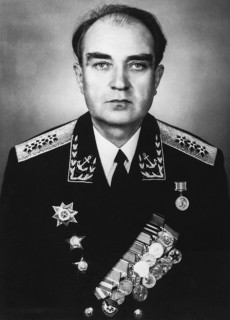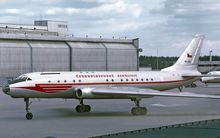
The Tupolev Tu-104 is a retired medium-range, narrow-body, twin turbojet-powered Soviet airliner. It was the second to enter regular service, behind the British de Havilland Comet and was the only jetliner operating in the world from 1956 to 1958, when the British jetliner was grounded due to safety concerns.
This is a list of aviation-related events from 1981.

The Tupolev Tu-124 is a 56-passenger short-range twinjet airliner built in the Soviet Union. It was the first Soviet airliner powered by turbofan engines.
This is a list of aviation-related events from 1973.
Kazakhstan Airlines was an airline from Kazakhstan, serving as national flag carrier of the country from its independence in 1991 until 1996. Following the disaster of the Charkhi Dadri mid-air collision, Kazakhstan Airlines ceased operations, and its role as flag carrier was transferred to Air Kazakhstan.

Aeroflot Flight 366, also known as the Miracle on the Neva, was a water landing by a Tupolev Tu-124 of the Soviet state airline Aeroflot. The aircraft took off from Tallinn-Ülemiste Airport (TLL) at 08:55 on 21 August 1963 with 45 passengers and 7 crew on board. The aircraft was built in 1962 and was scheduled to fly to Moscow–Vnukovo (VKO) under the command of 27-year-old captain Victor Mostovoy. After takeoff the nose gear did not retract. Ground control diverted the flight to Leningrad (LED) – because of fog at Tallinn.
This is a list of aviation-related events from 2010.

Dagestan Airlines Flight 372 was a scheduled commercial flight between Moscow's Vnukovo Airport and Makhachkala, Russia. On 4 December 2010, the Tupolev Tu-154 operating the flight skidded off the runway following an emergency landing at Domodedovo Airport, 45 kilometres (28 mi) south-east of Vnukovo. Two people on board were killed.

Aeroflot Flight 141 was an international flight from Moscow to Prague. On 19 February 1973, the Tupolev Tu-154 crashed 1.5 kilometres short of runway 25 of Prague Ruzyně Airport. Most of the passengers survived the crash, but many died in the fire that followed. Out of the 87 passengers and 13 crew members, 62 passengers and 4 crew members perished with 18 occupants having serious injuries and the remaining 16 with either minor or no injuries. The crash was the first loss of and first fatal accident involving the Tu-154.

Aeroflot Flight 03 was a passenger flight from Khabarovsk Airport to Petropavlovsk-Kamchatsky Airport. On 3 September 1962 the Aeroflot Tupolev Tu-104 lost control after the airframe started vibrating, resulting in the plane rolling and yawing several times at an altitude of 4,500 meters before crashing. The aircraft crashed into a swamp, some 90 kilometers away from Khabarovsk. At the time, it was the deadliest crash in the history of Soviet aviation.

Aeroflot Flight 99 was a Tupolev Tu-124 operating a scheduled domestic passenger flight from Leningrad to Murmansk, both in the Soviet Union, which crashed while attempting to land on 11 November 1965. Of the 64 passengers and crew on board, 32 were killed in the accident, and many of the survivors sustained injuries.

Aeroflot Flight 065 was a scheduled passenger flight operated by the International Civil Aviation Directorate division of Aeroflot. On 17 February 1966 at 1:38 am local time a Tupolev Tu-114 crashed during take-off from Sheremetyevo International Airport in Moscow, killing 21 of the 47 passengers and 19 crew members on board. This was the only fatal incident involving a Tu-114. A committee investigating the accident found that the crash was due to multiple crew and ATC failures.

Aeroflot Flight 2415 was a regularly scheduled passenger flight from Moscow to Leningrad that crashed shortly after takeoff on 28 November 1976. The cause of the accident was attributed to crew disorientation as a result of artificial horizon failure in low visibility conditions.

Aeroflot Flight 3739 was a regularly scheduled Russian domestic flight from Irkutsk to Pulkovo Airport in Saint Petersburg that crashed during takeoff from Irkutsk International Airport on 9 February 1976. Twenty-four of the 114 people on board died in the accident.

Aeroflot Flight 513 was a domestic scheduled passenger flight operated by Aeroflot that crashed during takeoff from Kuybyshev Airport in the Soviet Union on 8 March 1965, resulting in the deaths of 30 passengers and crew. It was the first fatal accident involving a Tupolev Tu-124.

The 1958 Aeroflot Тu-104 Kanash crash occurred on 17 October 1958 when a Tupolev Tu-104A operated by Aeroflot flying an international route from Beijing to Moscow crashed in bad weather near the town of Kanash, Chuvashia, Russia, four hundred miles east of Moscow, killing all 80 people on board. The flight was carrying high-level diplomatic delegations from numerous Soviet aligned countries such as China, East Germany, and Czechoslovakia. It was just the second fatal accident involving the Tu-104 which had been introduced into Aeroflot's inventory two years earlier, and the deadliest in the airline's history until the crash of Aeroflot Flight 902 in 1962.

Emil Nikolayevich Spiridonov was an officer of the Soviet Navy. He rose to the rank of admiral and was commander of the Pacific Fleet, before his death in the 1981 Pushkin Tu-104 crash, which also killed many of the Fleet's senior officers.

On 20 July 1992, a Tupolev Tu-154B cargo plane crashed during takeoff from Tbilisi-Novo Alexeyevka Airport in Georgia. The aircraft failed to become airborne and struck a residential area, killing all 24 on board and four more people on the ground. An investigation revealed that the aircraft's cargo was improperly loaded and partially undocumented, causing it to become overloaded.










